Victor Talking Machines
Portable Victrola Model VV 2-65
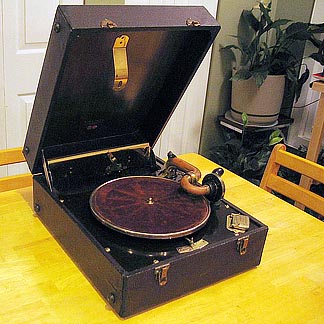 The RCA Victor VV 2-65 was the last acoustical record player made by Victor, between 1930 and 1933. This was an upscale machine with gold plated hardware, most of which has worn off on this example, and an automatic motor start and stop feature activated by the tone arm.
The RCA Victor VV 2-65 was the last acoustical record player made by Victor, between 1930 and 1933. This was an upscale machine with gold plated hardware, most of which has worn off on this example, and an automatic motor start and stop feature activated by the tone arm.
This particular machine has had a pretty rought life. The top of the cabinet was broken on both sides of the bottom near the hinge, the leatherette covering was coming loose at the corners, it was filthy and in poor condition; the handle was broken; and as mentioned above, most of the gold plating was worn off, especially on the tone-arm. The automatic start/stop mechanism was frozen solid and did not work.
On the plus side, the motor worked well, no thumping or banging, as does the Orthophonic sound box.
I glued and clamped the broken corners of the cabinet top. I re-glued all the loose leatherette with contact cement. I then cleaned the cabinet with Bleche-Wite, which revealed a nice burgundy colored cabinet. I then applied leather conditioner.
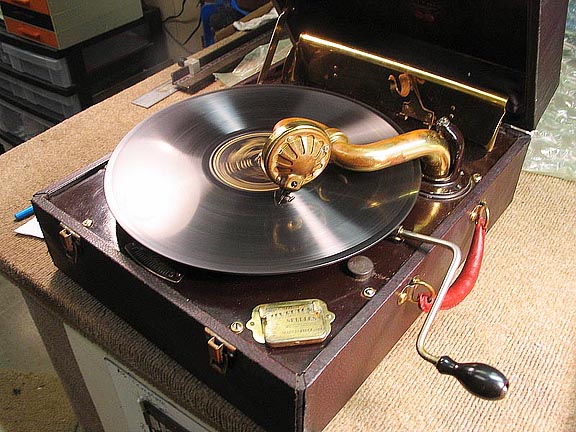 I found a suitable (but not identical) replacement handle on eBay and installed the new handle. I removed and polished all the hardware, although in most cases, I didn't see a lot of improvement. I didn't want to get too aggressive and remove the remaining gold plate.
I found a suitable (but not identical) replacement handle on eBay and installed the new handle. I removed and polished all the hardware, although in most cases, I didn't see a lot of improvement. I didn't want to get too aggressive and remove the remaining gold plate.
I peeled off the dingy turntable felt, which is actually more of a burgundy velvet material, and soaked it in white vinegar. When it dried, I re-glued it to the turntable.
I lubricated the gears in the motor, but did not disassemble it for further cleaning. I may do that if it starts getting noisy or not playing well. I used a strobe to adjust the speed at 78 rpm and it was dead on at center of the scale.
The most difficult part was repairing the automatic start/stop mechanism. I soaked it in white vinegar to free it up and then lubricated it. The two springs were completely worn out, which is why it didn't work. I had to purchase a 200 piece spring assortment from Harbor Freight and experiment with various combinations to get two springs that would work together properly, and still had to cut one down a bit. But now it works perfectly.
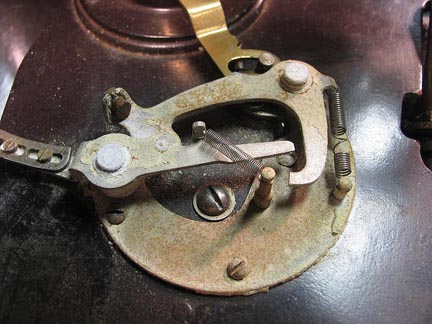 The audio quality depends a lot on the type of record playing. The later electronically recorded Victor records sound better and louder. Some of the older acoustical recordings lack volume, although some are better than others. I did disassemble the reproducer and lubricate the bearings and make sure the diaphragm was intact, but I haven't found the correct gaskets to replace those yet.
The audio quality depends a lot on the type of record playing. The later electronically recorded Victor records sound better and louder. Some of the older acoustical recordings lack volume, although some are better than others. I did disassemble the reproducer and lubricate the bearings and make sure the diaphragm was intact, but I haven't found the correct gaskets to replace those yet.
Here's a link to a You Tube video I made before I did most of the repairs, but you can get a sense of the audio quality.
Click Here for You Tube Video
1919 Victrola Model VV-XIa
 This upright Victrola has been in my wife's family since new. It belonged to her paternal grandparents. Unfortunately, as the photo at left shows, it has languished in a spare room of their old farmhouse for the last 60 years or so, and along the way, a number of parts disappeared. Most critically, the needle bar was missing from the No.2 Sound Box, and the speed control screw and dial cover were missing. Two knobs were missing from the cabinet, and the brake assembly was broken and a part missing. Fortunately, all these parts were easily obtained on eBay.
This upright Victrola has been in my wife's family since new. It belonged to her paternal grandparents. Unfortunately, as the photo at left shows, it has languished in a spare room of their old farmhouse for the last 60 years or so, and along the way, a number of parts disappeared. Most critically, the needle bar was missing from the No.2 Sound Box, and the speed control screw and dial cover were missing. Two knobs were missing from the cabinet, and the brake assembly was broken and a part missing. Fortunately, all these parts were easily obtained on eBay.
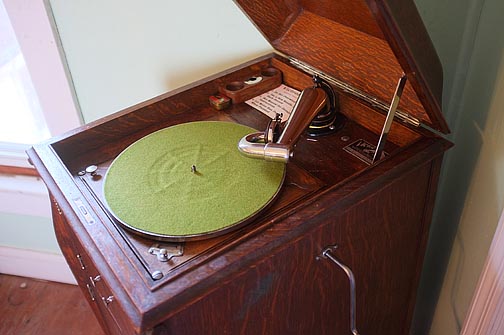 Victrola was the term used by the Victor Talking Machine Company to describe their record players that had an internal horn. The external horn models are called Victors.
Victrola was the term used by the Victor Talking Machine Company to describe their record players that had an internal horn. The external horn models are called Victors.
Both types are totally accoustical machines driven by spring type wind up motors. There isn't a single resistor, capacitor, tube, or coil to be found. In the 1920's, as electricity become more available, some Victrolas were offered with an electric motor, and were sometimes called Electrolas.
In 1924, 78rpm records recorded electrically with a microphone became available, and a new reproducer, or sound box, as Victor called them, the No.4, was introduced to provide better sound on the new records. They were backwards compatible with the pre-1924 Victrolas. Victor was acquired by RCA in the late 1920's, and the name Victor, Victrola, and the Nipper dog logo continued to appear on RCA products right up until their recent demise.
I removed the motor board and motor, along with the tone arm, turntable platter, and all the cabinet hardware, and brought them home to work on.
Once all the replacement parts arrived, I began the restoration. I found some excellent videos on You Tube on rebuilding the motor, so I disassembled it to clean out all the 96 year old hardened grease and oil. One of the 17 foot springs was broken on the end where it attaches to the rivet on the spring barrel. I was able to snip off the bad part, and drill a new hole. I cleaned the springs in solvent, then re-installed them in the barrel and packed them in bearing grease. The governor and speed control were all cleaned and reassembled in the motor.



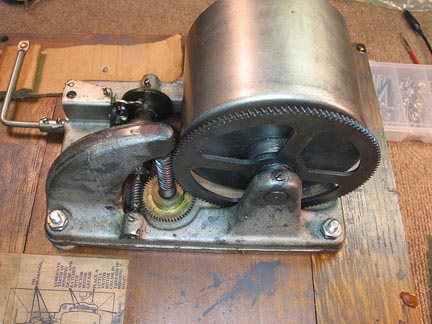
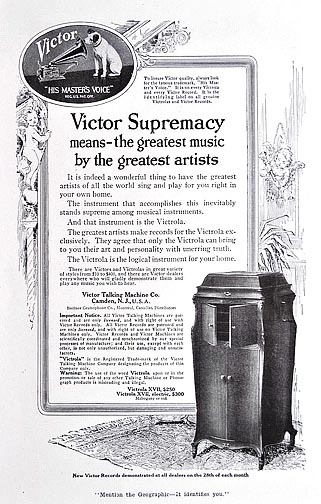
I used J-B Weld to re-attach the two pieces of the tone arm, and I rebuilt a used Victor No. 2 reproducer I bought on eBay with a kit I purchased online. I removed the old felt from the turntable platter and glued on a new piece of felt.
I cleaned up the cabinet with GoJo handcleaner and 0000 steel wool. I then went over it with Old English Scratch Cover, followed by polishing with Johnson's Past Wax. Although the original finish isn't too bad, much of the original varnish is crazed or worn away. However, I decided to leave the cabinet with its original finish.
Click Here for You Tube Video
Back to Record Player & Audio Menu



 The RCA Victor VV 2-65 was the last acoustical record player made by Victor, between 1930 and 1933. This was an upscale machine with gold plated hardware, most of which has worn off on this example, and an automatic motor start and stop feature activated by the tone arm.
The RCA Victor VV 2-65 was the last acoustical record player made by Victor, between 1930 and 1933. This was an upscale machine with gold plated hardware, most of which has worn off on this example, and an automatic motor start and stop feature activated by the tone arm. I found a suitable (but not identical) replacement handle on eBay and installed the new handle. I removed and polished all the hardware, although in most cases, I didn't see a lot of improvement. I didn't want to get too aggressive and remove the remaining gold plate.
I found a suitable (but not identical) replacement handle on eBay and installed the new handle. I removed and polished all the hardware, although in most cases, I didn't see a lot of improvement. I didn't want to get too aggressive and remove the remaining gold plate. The audio quality depends a lot on the type of record playing. The later electronically recorded Victor records sound better and louder. Some of the older acoustical recordings lack volume, although some are better than others. I did disassemble the reproducer and lubricate the bearings and make sure the diaphragm was intact, but I haven't found the correct gaskets to replace those yet.
The audio quality depends a lot on the type of record playing. The later electronically recorded Victor records sound better and louder. Some of the older acoustical recordings lack volume, although some are better than others. I did disassemble the reproducer and lubricate the bearings and make sure the diaphragm was intact, but I haven't found the correct gaskets to replace those yet. This upright Victrola has been in my wife's family since new. It belonged to her paternal grandparents. Unfortunately, as the photo at left shows, it has languished in a spare room of their old farmhouse for the last 60 years or so, and along the way, a number of parts disappeared. Most critically, the needle bar was missing from the No.2 Sound Box, and the speed control screw and dial cover were missing. Two knobs were missing from the cabinet, and the brake assembly was broken and a part missing. Fortunately, all these parts were easily obtained on eBay.
This upright Victrola has been in my wife's family since new. It belonged to her paternal grandparents. Unfortunately, as the photo at left shows, it has languished in a spare room of their old farmhouse for the last 60 years or so, and along the way, a number of parts disappeared. Most critically, the needle bar was missing from the No.2 Sound Box, and the speed control screw and dial cover were missing. Two knobs were missing from the cabinet, and the brake assembly was broken and a part missing. Fortunately, all these parts were easily obtained on eBay. Victrola was the term used by the Victor Talking Machine Company to describe their record players that had an internal horn. The external horn models are called Victors.
Victrola was the term used by the Victor Talking Machine Company to describe their record players that had an internal horn. The external horn models are called Victors.



